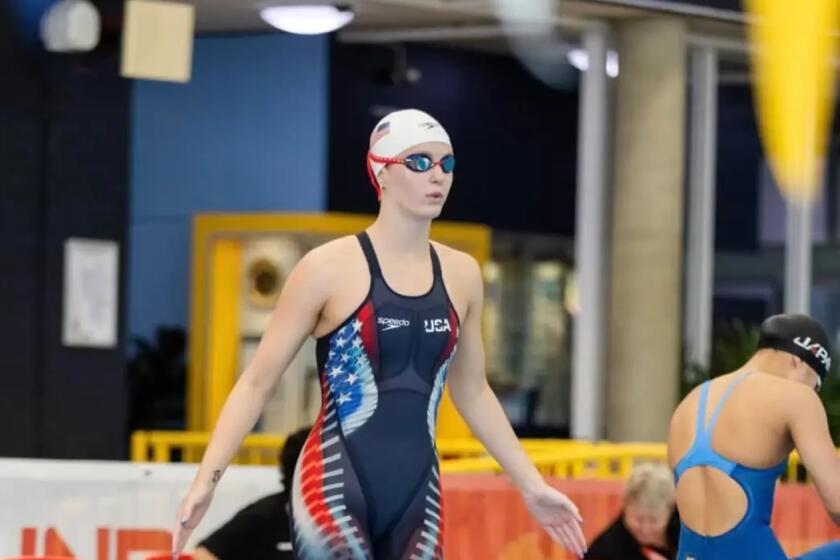Play ball with the NFL
- Share via
In Southern California, property development is a full-contact sport, and nobody plays the game with quite the brio of Industry-based Majestic Realty Co.
Its chairman and CEO, Ed Roski Jr., is an ex-Marine who turned the successful commercial real estate brokerage that his father founded into one of the nation’s biggest industrial property developers, making himself a billionaire in the process. Along with Denver billionaire Phil Anschutz, Roski developed Staples Center and the successful L.A. Live project that adjoins it. He retains a minority interest in both the Lakers and the Kings.
Roski’s current passion is bringing professional football back to the Los Angeles area, and to that end, he proposes building a privately financed, 75,000-seat stadium as part of a 600-acre mixed-use development in Industry, which is located near the junction of the 60 and 57 freeways in the southeast San Gabriel Valley.
It is in many ways the perfect place for a stadium -- a city that, as its name suggests, is always open for and to business. There are slightly more than 80 voters and no business taxes. Roski -- whose gleaming headquarters, with its museum-quality collection of African and Oceanic art, is located there -- has roots in the city deep enough to run all the way back to its incorporation.
Things there generally go his way.
John Semcken, the Majestic vice president who is Roski’s point man on the new stadium, as he was on Staples Center, told The Times on Friday that although there’s as yet no formal commitment from the National Football League, he’s “100% certain” that once the project is underway, the league will allow at least one existing team to move here. (Roski and Semcken are all too familiar with the wiles of the NFL; they’ve been involved in several unsuccessful bids to build stadiums in other local venues.)
The NFL has its own reasons to be particularly interested in the site. If you make Industry the center of a circle, one out of every 19 Americans lives within a 60-minute Sunday drive of the proposed stadium. The size of that market -- and the fact that the league currently has at least seven franchises unhappy in existing stadium deals across the country -- may be why, according to Semcken, the NFL asked Majestic to design a facility that could accommodate two teams.
So what’s the problem?
For nearly a year, the whole project has been tied up over environmental -- essentially traffic-related --objections raised by the nearby city of Walnut and by a variety of homeowners groups outside Industry.
Now, Majestic did not become the firm it is without acquiring the ability to swing a few political elbows, so in the waning days of the last legislative session, it persuaded the Assembly to pass a bill exempting the stadium from the environmental regulations on which Walnut’s suit was based. When the measure reached the state Senate, President Pro Tem Darrell Steinberg put it on hold and arranged for former L.A. County Dist. Atty. John Van de Kamp to privately mediate the dispute.
This week, the city of Walnut and Majestic did reach agreement, although one homeowners group is still holding out.
Even if that group continues to resist, the Senate should go ahead and grant Majestic its exemption.
Here’s why: This region is suffering through an employment crisis unmatched since the Depression. Unemployment is approaching 20% in some of Los Angeles’ hardest-hit communities, mainly the Latino and African American neighborhoods disproportionately dependent on jobs in the building trades. (In La Puente, one of the cities adjoining Industry, unemployment is 17%.)
According to Semcken and union officials who support the development, Majestic’s football stadium project will create 12,000 construction jobs and 6,732 permanent positions in the 1.4 million square feet of office space, 1.1 million square feet of retail and a 100,000-square-foot orthopedic medicine facility that will stand alongside the football facility.
All of this comes without the investment of a single public dollar, and, if that fails to impress, consider that the Dallas Cowboys’ lavish new stadium entailed expenditures of $933 million in public funds.
The Senate ought to be guided by the necessities of this wrenching historical moment. Nobody should take even tailored exemptions from our environmental laws lightly. But this is an instance in which dubious public process translates into good social policy.
--
More to Read
Go beyond the scoreboard
Get the latest on L.A.'s teams in the daily Sports Report newsletter.
You may occasionally receive promotional content from the Los Angeles Times.










